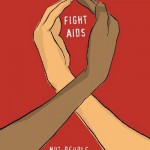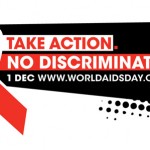 On December 1, 1988, the World Health Organization declared its first observance of World AIDS Day. Since that day 21 years ago, every December 1st has been used to raise awareness about the global HIV/AIDS pandemic. In 2006, the Political Declaration on AIDS set a goal to have “universal access to comprehensive prevention programmes, treatment, care and support by 2010.” While progress has been made, we are very far away from being able to trumpet that successes have been fully reached. For the year 2009, the theme of World AIDS Day is Universal Access and Human Rights.
On December 1, 1988, the World Health Organization declared its first observance of World AIDS Day. Since that day 21 years ago, every December 1st has been used to raise awareness about the global HIV/AIDS pandemic. In 2006, the Political Declaration on AIDS set a goal to have “universal access to comprehensive prevention programmes, treatment, care and support by 2010.” While progress has been made, we are very far away from being able to trumpet that successes have been fully reached. For the year 2009, the theme of World AIDS Day is Universal Access and Human Rights.
Currently, approximately 33 million people are living with HIV/AIDS (for a full set of global epidemiology slides, click here). Women constitute one half of the people living with HIV/AIDS, and this percentage has risen rapidly from 35% in 1985 (for a slide on the percentage of women in the epidemic around the world, see the UNAIDS epidemiology slides above). Shockingly, young people constitute one half of the new infections each year. While there is no cure for HIV/AIDS, anti-retrovirals have offered hope, newfound possibilities for health and well-being, and added years of life to millions of individuals, households, and communities around the globe. In the case of treatment, while many (but certainly not all) in the United States have access to life saving anti retroviral therapies, the availability of treatment is widely variable around the world. Unfortunately, only a small proportion of those with HIV/AIDS have access to anti-retro viral therapy. (For more details on the prevention, treatment, and care dynamics of the epidemic around the globe, see the UNAIDS 2008 Report on the Epidemic.)
Universal access as a theme is pointing to the need to ensure that populations have access to HIV/AIDS prevention, treatment, and care. This is easier said than done—in 2007 only 31% of people who needed treatment received it—and the rate of infection is far outpacing the increases in the number of people who are receiving treatment. Economic retractions around the globe threaten the progress that has been made and there are some reports that treatment programs are being halted or scaled back substantially given economic constraints (UNAIDS 2008 Report).
Because of the way that the number of infections is far outpacing those who have access to treatment, and because the epidemic is largely spread through drug use and sexual contact, the importance of prevention cannot be overstated. Prevention is well recognized as a key factor in slowing the pace of the epidemic—and this is not simply a matter of getting people much needed information and skills about condoms. Prevention is also about tending to the root causes of the epidemic, which involves issues related to social inequalities, homophobia, poverty, gender inequality, the criminalization of drug use and sex work, violations of human rights, and lack of health care access and infrastructure. And, then of course there are the complexities of culture and human behavior, and the fact that many prevention programs work for a short time, even up to a year, but these behavior changes are not often maintained in the long run. There is a great deal of promise in structural, interpersonal, cultural, and group level behavioral prevention interventions. However, the promise of these prevention interventions will not be fully realized without attention to social inequalities and human rights issues.
This brings us to the second aspect of the theme of World AIDS Day 2009: human rights. While it may not be obvious to many, violations of human rights shape HIV/AIDS risks and access to prevention, treatment, and care around the world. Men who have sex with men, sex workers, and drug users experience stigma and discrimination throughout the world. Many countries attempt to make HIV/AIDS a public health issue, but far too often, it is treated as a moral issue where populations are blamed for their fate (particularly sex workers, drug users, and men who have sex with men). Some countries do not even count “men who have sex with men” as a category in their surveillance systems and men who have sex with men have the lowest coverage of HIV prevention services of any category (UNAIDS, 2008). In numerous countries, women who are known to be HIV positive are thrown out of their homes when they test positive for HIV/AIDS and do not have adequate access to education, property rights, or income generation to help them to survive (and these factors shape their risks to begin with)—this is the case even when their partners may have infected them. In my own travels and research in South Africa and Kenya, it is clear that many women will not bring their children back to health care centers or clinics to be treated with ARVs for fear of being thrown out of their households and families by their male partners, relatives, or community members. Many men do not come to clinics to be tested because of HIV/AIDS stigma and because of perceptions that clinics are women’s spaces. Men also do not test because of ideals of masculinity which teach men to avoid signs of “weakness” or need. In many countries HIV positive women and men are subject to forced sterilization. Sex workers and drug users are often arrested and viewed as criminals, and prisons do not have adequate access to drug rehabilitation, condoms, or ARV’s, exacerbating the epidemic among “high risk” populations. And the U.S. has been known to stop funding prevention programs that take comprehensive sex education and condom use into account, arguing (against a very strong evidence-base) that abstinence and be faithful approaches work best (for studies that show that comprehensive sexual education and condoms work better than abstinence only programming, there are too many to list, but see this for one). The list of the links between social inequalities, rights, and HIV/AIDS risks goes on and on.
There have been gains, and there have been many of them. The number of people on anti-retroviral therapy has increased 10 fold in the past 6 years alone (UNAIDS, 2009). Recognition of the role of gender inequality and homophobia in shaping HIV/AIDS risks is increasing, as has prevention programming which is increasingly gender-specific and transformative for both women and men. Defining ‘human rights’ and implementing changes in rights has newfound momentum and if this continues, may provide marginalized populations with increased protections, resources, legal recourse, and access to prevention, treatment, and care. The US has a centralized dissemination program to diffuse evidence based successes to community based organizations. There is global mobilization to eradicate mother-to-child transmission. The economic contributions to prevention and a global scale ups in treatment have been a stunning testament to the fact that the global community can rally much needed support.
Still, there is much work to be done both domestically (U.S.) and globally. The incidence rate of HIV/AIDS in Washington DC is similar to that found in Western Kenya. The age distribution in some countries on the African continent has shifted life expectancy downward by several decades in several countries due to the epidemic. AIDS is the leading cause of death right now among African American women aged 25-34 in the United States and African-American women are 21 times more likely to die of HIV/AIDS than Caucasian women. There are millions of orphans due to HIV/AIDS. Sub-saharan Africa constitutes 10 percent of the world’s population and over 65% of the cases of HIV/AIDS. Anti-poverty efforts and food security efforts have been slow to link up with HIV/AIDS prevention, treatment, and care and are much needed. National policies have been hampered in their implementation by a lack of coordination, technical skill, and competing economic and health needs. Young people need prevention efforts more than ever before and prevention efforts reach adults the most. To achieve universal access and human rights within the HIV/AIDS epidemic is a goal that all social sectors and countries must all strive for. At the same time, all must be mindful that recalcitrant issues such as social inequalities and social justice shape the epidemic profoundly and must be dealt with head on in action and not in rhetoric.
__________________
For more information on the AIDS pandemic and how you can get involved in advocacy, research, or activism see the following links:
- World AIDS Campaign
- The Body (“The Complete HIV/AIDS Resource”)
- European Medical Students Association
- Avert (an international AIDS charity)
- UNAIDS
- International Center for Research on Women
- Sonke Gender Justice
- Treatment Action Campaign
- Prevention Trials Network
- AIDS Free World
- Global Coalition on Women and AIDS
- CDC-Centers for Disease Control
- CHAMP (Community Health AIDS Mobilization Project)


Comments 3
Tweets that mention December 1st is World AIDS Day–theme is “Universal Access and Human Rights” » Sexuality and Society -- Topsy.com — December 1, 2009
[...] This post was mentioned on Twitter by Tine and GFE London-Escorts, Ingrid Serck-Hanssen. Ingrid Serck-Hanssen said: December 1st is World AIDS Day–theme is “Universal Access and ... http://bit.ly/8a3ePV [...]
Escorts in London — December 13, 2009
That is great. Thank you very much for sharing.
Top Ten Sexual Stories of 2009 » Sexuality and Society — December 31, 2009
[...] HIV/AIDS rates in sub-saharan Africa continue to soar, and condoms are very effective in fighting HIV/AIDS (when used correctly and consistently) Pope [...]